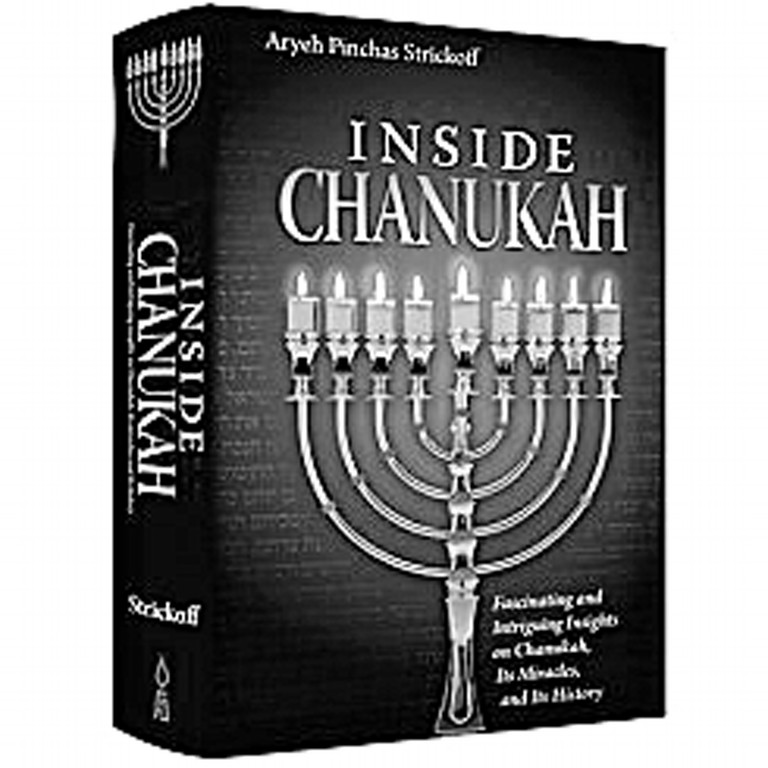The Kosher Bookworm Inside Chanukah - A complete historical presentation
Rabbi Aryeh Pinchas Strickoff, author of the recently published work, “Inside Chanukah: Fascinating and Intriguing Insights on Chanukah, Its Miracles, and its History” [Feldheim 2012] perhaps said it best in his perceptive opening preface:
“Jewish holidays serve a much loftier purpose than simply marking special moments in time or commemorating historical events, though those functions are no doubt important. The fundamental goal of celebrating the Jewish holidays is the internalization of the specific messages each respectively imparts, to help us grow spiritually and ultimately draw closer to G-d. The holiday of Chanukah is no different. During the cold and dark days of the month of Kislev, Chanukah comes with its message of hope and lights to inspire every Jew to recognize the enormous potential within his soul.”
Within the contents of this large and comprehensive 700 page work can be found just about every major topic and teaching related to the Chanukah story. From ritual practice to history, the author brings to the lay reader a fully annotated work of pure scholarship that includes 700 fully annotated footnotes, textual sources that include historical texts and their background, Talmudic and Rabbinic texts, a Torah perspective on the holiday’s historical texts, and the historical context of the holiday.
Also to be found, are detailed descriptions of the laws and practices that give the holiday its unique flavor and image. All of this is presented with relevant historical background and geographic detail in plain and clear English, absent the technical jargon so common in other works. And there is much more.
One fascinating chapter is “section seven” wherein is found the answers to the following two pivotal questions:
1.“Why does Chanukah always coincide with the parashiyot that tell the story of Joseph [ Vayeshev, Mikeitz, and Vayigash] ?
2.“What is the underlying parallel between Chanukah and these three parashiyot, which, depending on the year, we read during Chanukah ?”
Each one of these three Torah portions are given detailed analytical treatment, in a question and answer format, that serves to further expand the reader’s knowledge of the basic themes and teachings of this holiday. This chapter not only helps us to gain a better perspective of Chanukah’s importance, it also gives us a better and deeper appreciation of the whole story of Joseph in its theological, as well as historical, perspective, especially in light of the Chanukah episode.
Another unique feature that is presented in this work, is a detailed English commentary of the famed piyut of praise, “Maoz Tzur,”
which, in and of itself, serves as a history-based timeline of the Jewish people.
This most informative and learned commentary is based upon the interpretations found in Siddur Avodat Yisrael; Yalkut Ohr HaGanuz L’Yemei Chanukah; Rabbi Avraham Rosenwasser’s Sefer Pardes HaChanukah; and Rabbi Tzvi Cohen’s Chanukah: Halachot U’Minhagim.
Hopefully this commentary compilation of Maoz Tzur will eventually find its way into standard siddurim for the edification of all.
Note is made by the author of those whose scholarship was referenced in the compilation of this great work. Among those cited and acknowledged with grace are Rabbi Dr. Berel Wein of the Discovery Institute in Jerusalem, Dr. Shnayer Leiman of Brooklyn College, and the dean of American Jewish historians, Dr. Louis Feldman of Yeshiva University.
While otherwise not cited directly, the introductory essay, “Judaism vs. Hellenism,” seems to reflect collectively the work of these three outstanding scholars and surely deserves your attention. Further, as a tribute to Rabbi Strickoff’s meticulous scholarship, we find in his “Author’s Note” that follows this essay, a series of qualifications concerning some of the historical terms used in this work. One in particular deserves mention in its entirety, as a crucial lesson for us to learn when studying the history of Chanukah.
“Unless otherwise noted, references in this sefer to ‘Yavan’ [literally, Greece] generally refers to the Syrian-Greek kingdom ruled by Antiochus from his capital city Antioch in Syria that dominated the Land of Israel during the time of Chanukah.
After the demise of Alexander the Great, his great Greek kingdom was divided amongst his three generals, creating three separate and independent Greek kingdoms in Asia Minor, Egypt, and Syria respectively. Thus, it is important to specify which kingdom one is referring to when using the term Yavan for the Greeks during that time period. Alternatively, as it may apply in the context, Yavan may also refer to Greek culture and society in general.”
This carefully crafted qualification makes this entire work a must read this coming Chanukah. The intellectual integrity that is at the foundation of this work, makes it one of the best Chanukah books ever authored in English for the Jewish layperson.
FOR FURTHER STUDY
Recognizing that the City of Jerusalem is at the geographic center of the Chanukah study, two very important works concerning Ir Yerushalayim deserve your attention. Both are authored by Ahron Horowitz, the director of the City of David Institute for Jerusalem Studies [Megalim].These two works, “City of David: The Story of Ancient Jerusalem” and “Discovering the City of David: A Journey to the Source,” gives you a front row view of what ancient Jerusalem was like, based upon the work of Megalim and the archaeological discoveries that they are involved in. Their project site, located near the Kotel, is a must visit for anyone seriously interested in the history of Jerusalem.

 50.0°,
Overcast
50.0°,
Overcast 







